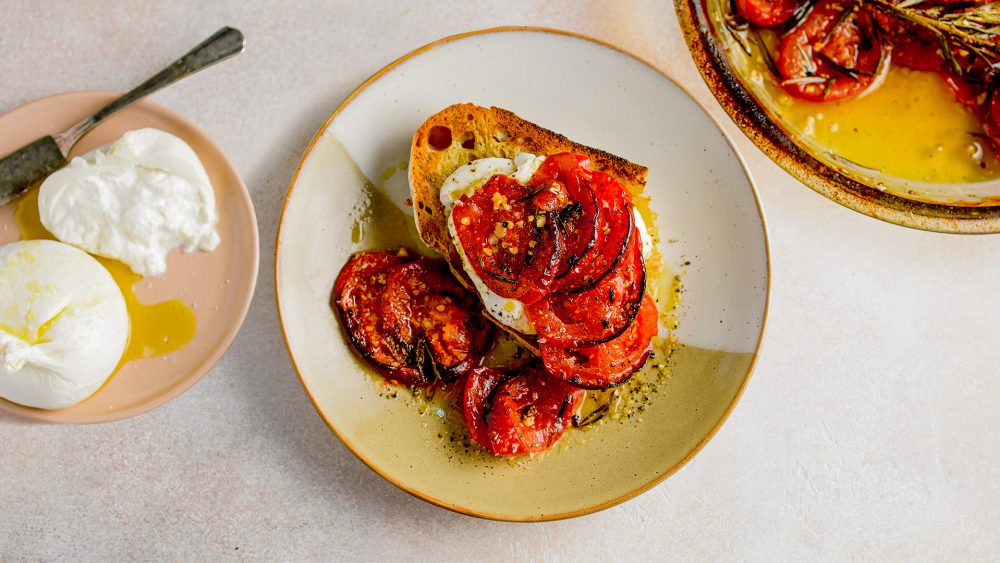And don't get me started on supermarket tomatoes. Those "heirloom" tomatoes LOOK great but taste no better than typical beefsteak tomatoes. Yes, cherry or grape tomatoes are better, but still lack that singular aroma that is the calling card of every tasty tomato. (As a child, I remember the pungent aroma of a just-picked tomato, packed with juicy flavor and ripeness. But, as I said, this is now just a distant memory.)
And even when I grow tomatoes myself, I have had mixed success with the larger varieties such as Roma and Black Beauties, though I find the SunGold cherry tomatoes to be flavorful. They make a good base for a simple sauce for nearly any type of pasta—try them in spaghetti aglio e olio, in this one-pot tortellini with salami, or with rigatoni with anchovies (which will really up the umami and make up for any lack of flavor on the tomato’s part).
But the overall situation cries out for a remedy, a means of transforming a mediocre supermarket specimen into something worthy. For starters, you can salt them and drain away the excess water in a colander, like we do for our Upside-Down Tomato Tart and this Grape Tomato Salad with Parsley and Dill. This seasons the tomatoes and gives them a meatier texture and truer flavor. And in the case of the tart, it prevents the moisture from seeping out during baking and ruining the crust.

You also can roast them, bake them, simmer them or stir-fry them to drive off water and concentrate their flavor. For particularly lackluster tomatoes, slowly roast them, then pair them with ingredients that wake them up, like tomato paste (to up the savoriness) and white balsamic (to brighten). Slow-roasted tomatoes make a powerful pantry staple; add them to sandwiches and salads, or—for an easy supper—polenta.

And, if by some stroke of luck, you come across a good tomato, I have a few recipes that will put them to good use:
- Burmese Tomato Salad with Shallots and Peanuts: Based on a recipe from Amy and Emily Chung’s book “The Rangoon Sisters,” this salad doesn’t overpower tomatoes’ freshness—it complements it with surprising textures and flavor pops: chilies, crunchy peanuts and crispy shallots, along with a little umami-rich fish sauce and lime juice.
- Summer Tomato Tian: A classic French tian (named after the shallow earthenware vessel in which it is baked) usually showcases a variety of summer produce, but here the focus is on tomatoes seasoned with garlic and herbs. We use plum tomatoes, which are firmer and drier than regular round tomatoes, because they withstand long baking and yield deep, rich, concentrated flavor. Serve warm with good bread and cheese.
- Tomato Salad with Chipotle-Sesame Dressing: The dressing for this salad is inspired by Mexican salsa macha, which is made with dried chilies, garlic, nuts and seeds that are fried in oil, then pureed. We skipped the blender and deconstructed the salsa, adding the ingredients directly to the salad—the fried peanuts and sesame seeds add a lovely texture.
- Andalusian Chilled Tomato Soup: Way better than gazpacho. Based on the richly flavored, no-cook chilled soup called salmorejo from Andalusia, it’s thickened with bread for a creamy consistency (without any cream).
Finally, don’t ever store your tomatoes in the fridge—especially if you manage to find one that actually tastes like something. The chill will dull whatever flavor they have and make them mealy. Keep them on the counter and eat them promptly.
Join the conversation on Facebook, Instagram, TikTok and Pinterest.
And if you're looking for more Milk Street, check out our livestream cooking classes with our favorite chefs, home cooks and friends for global recipes, cooking methods and more.








